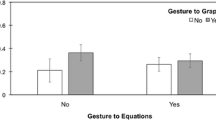Abstract
Most research on gestures (especially in the field of Mathematics Education) has focused on gestures in communication with others. In contrast, here, we focus on gestures which are not directed at others, but which we assume accompany inner speech or embodied thought, such as the gesticulation one makes by touching one’s fingers whilst silently counting; that is, whilst thinking, or communicating with oneself. Typically, these gestures are accompanied by eye gaze, which is detached from others who are present and turned either inwards or towards relevant artefacts present. Additionally, these gestures—whilst structurally similar—are much smaller than “normal” gestures used in interpersonal communication, suggesting an attenuation parallel to that found in inner speech. These physical gestures are in effect objectifications for oneself, which we can interpret as a not-quite-yet “underground” part of embodied thought. We suggest that they might be particularly vital for understanding the imagistic, visuospatial dimension of mathematics in general and fractions in particular.









Similar content being viewed by others
Notes
Follow this link (http://stream.manchester.ac.uk/Play.aspx?VideoId=5592) to view Zak’s gestures.
Follow this link (http://stream.manchester.ac.uk/Play.aspx?VideoId=5591) to view Nora’s gestures.
References
Behr, M. J., Harel, G., Post, T., & Lesh, R. (1992). Rational number, ratio, proportion. In D. A. Grouws (Ed.), Handbook of research on mathematics teaching and learning (pp. 296–333). New York: Macmillan.
Cramer, K. A., Post, T. R., & delMas, R. C. (2002). Initial fraction learning by fourth- and fifth-grade students: A comparison of the effects of using commercial curricula with the effects of using the rational number project curriculum. Journal for Research in Mathematics Education, 33(2), 111–143.
Edwards, L. (2009). Gestures and conceptual integration in mathematical talk. Educational Studies in Mathematics, 70, 127–141.
Empson, S. B., Junk, D., Dominguez, H., & Turner, E. (2005). Fractions as the coordination of multiplicatively related quantities: A cross-sectional study of children’s thinking. In T. Dreyfus, B. Barton, P. Boero, N. C. Presmeg, & H. Steinbring (Eds.). Educational Studies in Mathematics, 63, 1–28.
Goldin-Meadow, S. (2005). The two faces of gestures: Language and thought. Gesture, 5, 241–257.
Goldin-Meadow, S. (2006). Talking and thinking with our hands. Current Directions in Psychological Science, 15, 34–39.
Kendon, A. (2004). Reviews [Review of the hearing gesture: How our hands help us think, by S. Goldin-Meadow]. Gesture, 4, 91–107.
Lakoff, G., & Nunez, R. (1997). The metaphorical structure of mathematics: Sketching out cognitive foundation for a mind-based mathematics. In L. English (Ed.), Mathematical reasoning: Analogies, metaphors and images (pp. 21–89). New Jersey: Erlbaum.
Lakoff, G., & Nunez, R. (2000). Where mathematics comes from: How the embodied mind brings mathematics into being. New York: Basic Books.
Lamon, S. J. (1996). The development of unitizing: Its role in children’s partitioning strategies. Journal for Research in Mathematics Education, 2, 170–193.
Mamede, E., Nunes, T., & Bryant, P. (2005). The equivalence and ordering of fractions in part–whole and quotient situations. In H. L. Chick & J. L. Vincent (Eds.), Proceedings of the 29th Conference of the International Group for the Psychology of Mathematics Education (Vol. 3, pp. 281–288). Australia: University of Melbourne.
McNeill, D. (1992). Hand and mind. Chicago: University of Chicago Press.
McNeill, D. (2005). Gesture and thought. Chicago: University of Chicago Press.
Monroe, E. E., & Nelson, M. (2002). Egg cartons revisited. In G. Dunn, R. Stewart, and H. Williams (Eds.). Mathematics Teaching, 179, 11–14.
Nunez, R., Edwards, L., & Matos, J. F. (1999). Embodied cognition as grounding for situatedness and context in mathematics education. Educational Studies in Mathematics, 39(1–3), 45–65.
Radford, L. (2005). Why do gestures matter? Gestures as semiotic means of objectification. In H. L. Chick & J. L. Vincent (Eds.), Proceedings of the 29th Conference of the International Group for the Psychology of Mathematics Education (Vol. 1, pp. 143–145). Australia: University of Melbourne.
Radford, L. (2006). Algebraic thinking and the generalization of patterns: A semiotic perspective. In S. Alatorre, J. L. Cortina, M. Saiz, & A. Mendez (Eds.), Proceedings of the 28th annual meeting of the North American Chapter of the International Group for the Psychology of Mathematics Education (Vol. 1, pp. 2–21). Mérida: Universidad Pedagógica Nacional.
Radford, L. (2008). The ethics of being and knowing: Towards a cultural theory of learning. In L. Radford, G. Schubring, & F. Seeger (Eds.), Semiotics in mathematics education: Epistemology, history, classroom and culture (pp. 215–234). Rotterdam: Sense Publishers.
Radford, L. (2009). Why gestures matter? Sensuous cognition and the palpability of mathematical meanings. Educational Studies in Mathematics, 70(3), 111–126.
Ryan, J., & Williams, J. (2007). Children’s mathematics 4–15: Learning from errors and misconceptions. UK: Open University Press.
Sabena, C., Yoon, C., Arzarello, F., Dreyfus, T., Paola, D., & Thomas, M. (2009). Relationships and control within semiotic bundles. In M. Tzekaki, M. Kaldrimidou, & H. Sakonidis (Eds.), Proceedings of the 33rd Conference of the International Group for the Psychology of Mathematics Education (Vol. 5, pp. 33–40). Greece: PME.
Vygotsky, L. (1978). Mind in society. In Cole, M., John-Steiner, V., Scribner, S., & Souberman, E. (Eds.). Cambridge, MA: Harvard University Press.
Vygotsky, L. (2000) (Original, 1934). Thought and language (A. Kozulin, Ed. & Trans.). USA: MIT.
Williams, J. (2009). Embodied multi-modal communication from the perspective of activity theory. Educational Studies of Mathematics, 70, 201–210.
Yoon, C., Thomas, M. O. J., & Dreyfus, T. (2009). Gestures and virtual space. In M. Tzekaki, M. Kaldrimidou, & H. Sakonidis (Eds.), Proceedings of the 33rd Conference of the International Group for the Psychology of Mathematics Education (Vol. 5, pp. 409–416). Greece: PME.
Zurina Harun (2010). Evaluating the teaching and learning of fractions through modelling in Brunei: Measurement and semiotic analyses. Thesis, University of Manchester, Manchester, UK.
Author information
Authors and Affiliations
Corresponding author
Rights and permissions
About this article
Cite this article
Zurina, H., Williams, J. Gesturing for oneself. Educ Stud Math 77, 175–188 (2011). https://doi.org/10.1007/s10649-010-9294-x
Published:
Issue Date:
DOI: https://doi.org/10.1007/s10649-010-9294-x




